#ring nebula
Text

The Ring Nebula l Webb via NASA APOD
#nasa#webb#astrophotography#astronomy#james webb telescope#apod#solar system#ring nebula#stars#galaxy#sky#universe#space
2K notes
·
View notes
Photo

Remains of a sun-like star: The Ring Nebula
#nasa#apod#hubble telescope#ring nebula#space#astrophotography#nebula#stars#night sky#astronomy#university#galaxy#cosmos#planet#solar system#planets
878 notes
·
View notes
Text

SPACEMAS DAY 17 ✨🪐🌎☄️☀️🌕
The Ring Nebula (M57), is more complicated than it appears through a small telescope. The easily visible central ring is about one light-year across, but this remarkable exposure by the James Webb Space Telescope explores this popular nebula with an exposure in infrared light. Strings of gas, like eyelashes around a cosmic eye, become evident around the nebula in this digitally enhanced featured image in assigned colors. These long filaments may be caused by the shadowing of knots of dense gas in the ring from energetic light emitted within. The Ring Nebula is an elongated planetary nebula, a type of gas cloud created when a Sun-like star evolves to throw off its outer atmosphere to become a white dwarf star. The central oval in the Ring Nebula lies about 2,500 light-years away toward the musical constellation Lyra.
Image Credit & Copyright: NASA, ESA, CST, JWST
#astronomy#space#science#universe#nebula#ring nebula#spacemas#day 17#infrared#jwst#james webb space telescope#red#blue#yellow#filaments#planetary nebula#sun like star#sun#follow#like#reblog#the first star#the first starr#thefirststar#thefirststarr#nasa#apod#tumblr#blog#space blog
157 notes
·
View notes
Text
In a new discovery released on August 21, 2023, James Webb Telescope captures remarkable images of the iconic Ring Nebula.
Read full article here
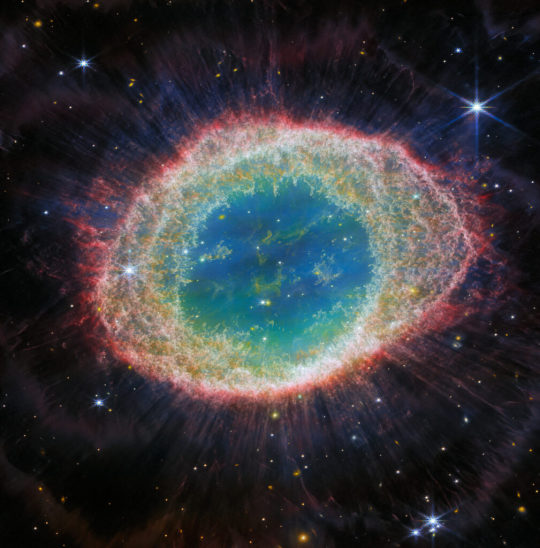
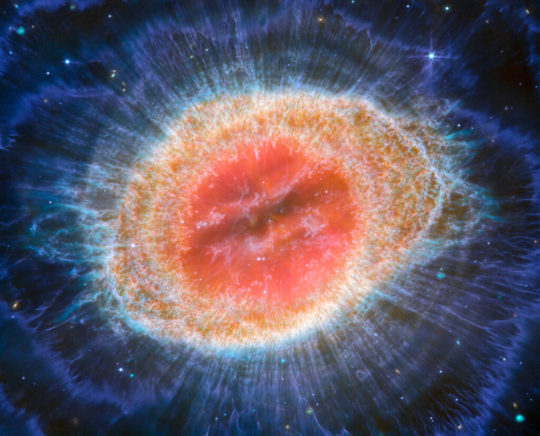
254 notes
·
View notes
Text
I love these pictures of the Ring Nebula. It’s so beautiful! And it look like an eye too!

James Webb Space Telescope
#space#space images#space photography#james webb space telescope#JWST#james webb images#ring nebula#it looks like an eye!#special interest#feel free to share/reblog#James Webb Space Telescope (Facebook)
119 notes
·
View notes
Text

Near-Infrared Ring
158 notes
·
View notes
Text

The Ring Nebula, M57 // Alberto Lopez
In this image, you can see the multicolored aspect of the Ring Nebula. The blue-green color at the center is caused by doubly-ionized oxygen, that is, oxygen atoms with two electrons removed. The reddish colors is caused by a combination of mostly ionized hydrogen and some singly-ionized nitrogen.
#astronomy#astrophotography#messier marathon#nebula#emission nebula#planetary nebula#ring nebula#messier#messier 57#M57#NGC 6720#lyra
59 notes
·
View notes
Text
"what's your current obsession?" space pictures.


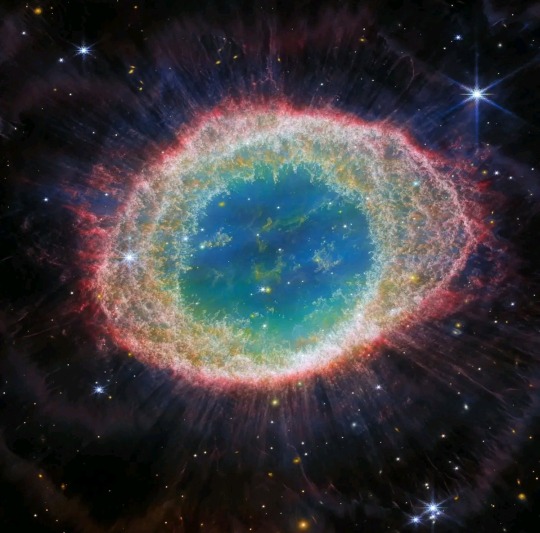

lmk if you want a part 2 and what to put in it🥳
59 notes
·
View notes
Text
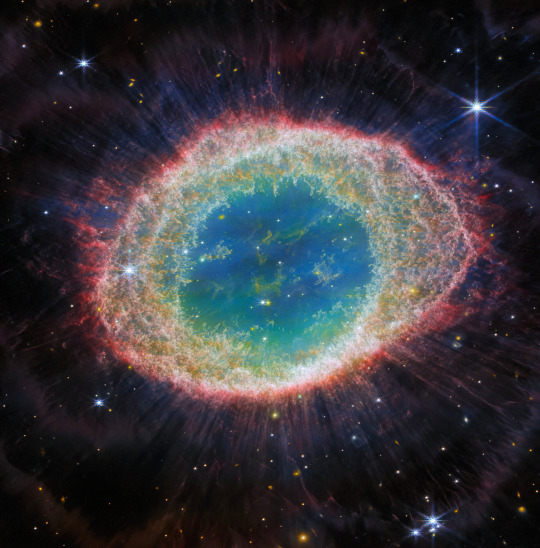
JWST’s latest view of the Ring Nebula. Filledelespace has an explanation at the link below.
87 notes
·
View notes
Text

M57, or the Ring Nebula, is a planetary nebula, the glowing remains of a sun-like star.

This image by Bray Falls

Distance - 2,000 light-years
62 notes
·
View notes
Photo


James Webb telescope captures the Ring Nebula in brilliant focus : NPR
first image: The famous Ring Nebula is seen in brilliant new clarity, thanks to a new James Webb Space Telescope image released by researchers in the JWST Ring Nebula Imaging Project. The image was processed by Roger Wesson, according to Western University in Ontario. NASA/ESA/CSA
second image: The Ring Nebula is seen in a 2013 image captured by NASA's Hubble Space Telescope. A new image has shown even more complexity within the famous nebula.
81 notes
·
View notes
Text
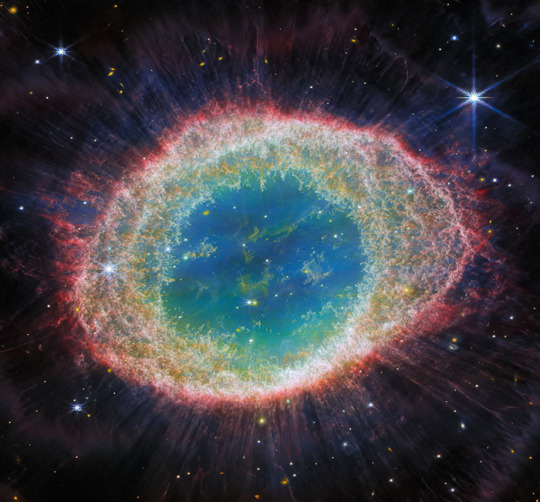

Details of Ring Nebula l Webb NIR/MIRI
#webb#nebula#james webb space telescope#nasa#space#astrophotography#astronomy#stars#ring nebula#night#galaxy#planets#sky#solar system#universe
883 notes
·
View notes
Text
The James Webb Space Telescope has imaged the Ring Nebula as a glowing green and purple eye, presenting the familiar astronomical object in an altogether new light.
Aside from its stunning aesthetic value, the James Webb Space Telescope (JWST) images show the Ring Nebula, also known as Messier 57 (M57), located around 2,200 light-years away, in intricate detail that will surprise even astronomers who are familiar with the object.
Located in the Lyra constellation, the Ring Nebula is a popular target for space enthusiasts as its donut-shaped ring of glowing gas and dust is visible even with small backyard telescopes throughout the summer.
"I first saw the Ring Nebula as a kid through just a small telescope," Western University astrophysicist and core member of JWST Ring Nebula Imaging Project, Jan Cami, said in a statement. "I would have never thought that one day, I would be part of the team that would use the world's most powerful space telescope ever built to look at this object."
The Ring Nebula is the glowing remains of a long-dead star, a class of astronomical object called a "planetary nebula," which somewhat confusingly has nothing to do with planets. At its heart is a white speck that represents a white dwarf star — what remains of that extinct stellar body's core.
Continue Reading
67 notes
·
View notes
Text

The Ring Nebula (M57), is more complicated than it appears through a small telescope. The central ring is about one light-year across, but this remarkable exposure by the James Webb Space Telescope explores this popular nebula with a deep exposure in infrared light. Strings of gas, like eyelashes around a cosmic eye, are shown around the Ring in this digitally enhanced featured image in assigned colors. The long filaments may be caused by shadowing of the knots of dense gas in the nebula by light emitted within. The Ring Nebula is an elongated planetary nebula, a type of gas cloud created when a Sun-like star evolves to throw off its outer atmosphere to become a white dwarf star. The central oval in the Ring Nebula lies about 2,500 light-years away toward the constellation Lyra.
Credit: NASA, ESA, CSA, JWST; Processing: Zi Yang Kong
#astronomy#space#science#universe#nebula#ring#ring nebula#emissions#shadow#light#planetary#planetary nebula#Lyra#constellation#planets#deep space#James Webb#james webb telescope#james webb images#follow#like#reblog#the first star#the first starr#thefirststar#thefirststarr#nasa#apod#tumblr#blog
165 notes
·
View notes
Text


17 notes
·
View notes
